I admit it: I love Martha Stewart. She drives me crazy, but her involved-yet-ever-so-elegant craft projects? Her table centerpieces? And her recipes which cause me to swoon (when reading) and curse (when preparing – I mean, who wants to spend six hours on a cupcake recipe?). She’s the queen of aspirational living.
So when Martha started showing off her latest obsession, faux bois (“false wood”, or wood-looking items made of concrete), I was hooked. I love wood grain! (I’m a landscaper, it’s in the rules.) I’m thrilled to see it as a pattern for home décor, but even more excited to examine how it can be used in landscaping. (Faux bois above by Donald Tucker)
We’ve all seen normal stamped concrete patios. But what about a faux bois concrete patio (from The Lil House That Could)?
These rustic bird baths (from Carlos Cortes and Rituals Décor) have ridges and rough surfaces that birds can grip with their feet, making them useful to wildlife as well as decorative:
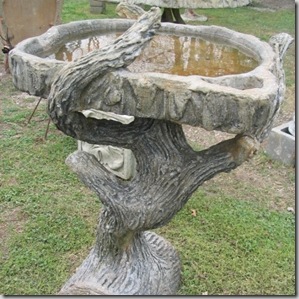 |
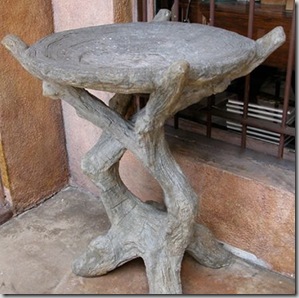 |
And there are faux bois planters (from Deb Silver):

I should probably make a distinction here between things that have a wood grain pattern and faux bois as an art. You can certainly describe the patio at top as being faux bois, but it was created using concrete stamps that resemble wood boards. You can also create a wood-grain finish by board-forming your concrete, like this (from Concrete Network):
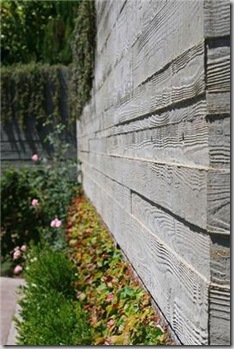
But faux bois as an art form is more akin to sculpture, taking days of non-stop work to get just the right appearance and finish (all work below by Donald Tucker).
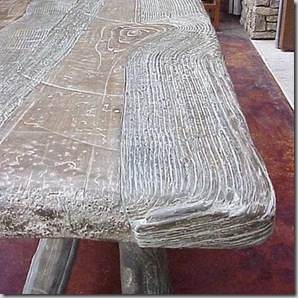 |
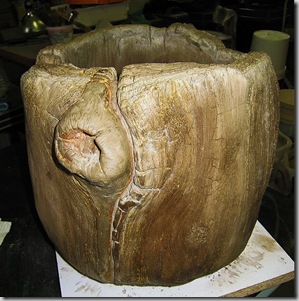 |
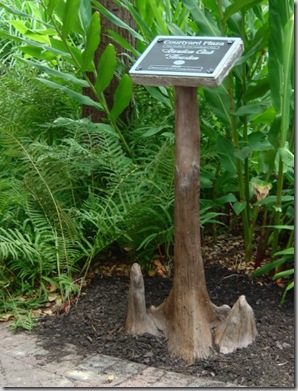 |
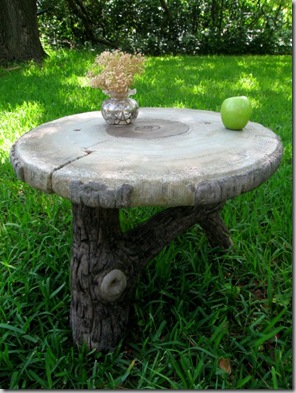 |
It’s not all that common, because few artisans know how to do the techniques, and it’s so labor-intensive that you’d need to reach a very appreciative market in order to make it a worthwhile endeavor. Yet these sculptures can last for generations – artist Donald Tucker estimates fifty thousand years if properly created.
If you’d like to try doing it yourself, I found this tutorial online by Ken Druse. Or, if you really want to learn the techniques properly, Donald Tucker offers five-day seminars on the technique. These flickr photosets give you an idea of what’s involved in a big project: part one and part two.
There’s also a coffee table book, Capturing Nature, about artist Carlos Cortes’ great uncle Dionicio Rodriguez, who is widely recognized as a master at the craft.
I love how the faux bois theme mixes natural with manmade, and I think it would make a unique touch in a rustic or woodland garden.
What do you think? Do you like the look of it, or should we stick with wood for a wood-like look?
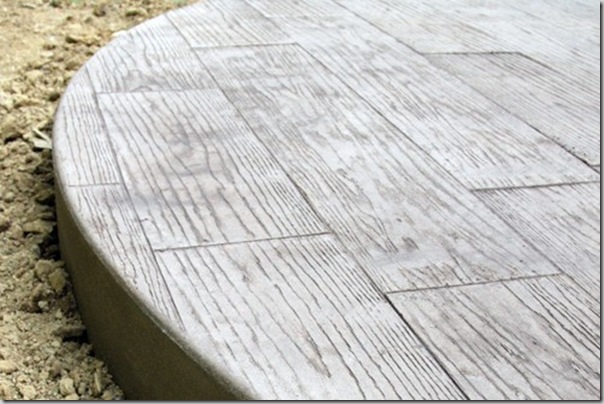
20 responses to “Faux Bois: False Wood”
Like so many things, craftsmanship and a good eye for detail make all the difference. I like Donald Tucker’s work a lot but that patio? Not so much.
It’s interesting how tastes vary. I actually quite dig the patio, because I detect a sense of irony and fun there. If I suspected the contractor was approaching it with no humor, I’d like it a lot less.
Not a big fan of concrete in general, but I guess if you live in a wet climate, longer-lasting hardscaping starts to look pretty desirable…
Yeah, I’m a fan of using hardscaping in small quantities so that it feels in scale with the surroundings. I’m glad there are new permeable types of concrete, which helps make it more eco!
Oh, I love it! I’ve seen faux bois patio furniture, and “siding.” I love it, but never really thought about it as something I could have in my garden.
I especially love the birdbaths! So much nicer than the plain concrete versions.
Me, too! They seem so gnarled and full of character.
I like most of what you show here, but don’t like the patio that well. Brick is still my favorite for patios. Perhaps it looks better from a distance or in context rather than judging it by the macro view.
Thanks for sharing the story about faux bois!
I like the Donald Tucker creations and the bird baths.
However, as a woodcarver I more appreciate wood (i.e. woodcarving works and chainsaw carving sculptures) over concrete.
BRILLIANT idea for a blog post!!
I agree that wood is more “natural” but unless you’re re-purposing the wood or have a dependable replacement supply, the concrete will endure and may be more “sustainable. The concrete that has been colored and weathered to look more like wood is definately place-able in the landscape.
I love faux bois, but only when done well, such as in your examples. I can’t stand plastic stuff stamped to look like wood, but that’s really an entirely different thing than what you’re talking about. I think its ingenious to use it in a landscape when you might WANT to use wood but can’t because it won’t hold up. Love it. But I probably won’t be making my own anytime soon. After all, we have to leave SOME things to Martha, right?
First off, thank you for the kind words and for sharing my work. I just wanted to make a brief point regarding ferrocement Faux Bois. The whole idea is to celebrate a very brief moment in nature. Everyone seems to love the look of gnarly old, weathered wood, but that moment of it’s existence is fleeting and it soon succumbs to decay. Sculpted cement can capture and hold that delicate moment in time for many generations. Some sculpt & erect statues of great people to hold their short lived glory in time. I humbly try my best to do the same for what is to me, one nature’s of most intriguing and glorious creations.
Donald, thank you so much for stopping by and sharing your perspective. I love what you’ve said about capturing a moment in time that would otherwise decay away. Beautifully put.
Mister Rodriguez was not related at all to mister cortes, is just a necessary myth for $ purposes. sorry.
Really? Can you tell us more, Gregory?
Maximo Cortez was father to Carlos Cortez and worked alongside his uncle Dionicio Rodriguez for decades. This makes Carlos the grandnephew of his great-uncle.
Spelling Corrections:
Maximo Cortés was father to Carlos Cortés and worked alongside his uncle Dionicio Rodriguez for decades. This makes Carlos the grandnephew of his great-uncle.
I read the book about dionicio throughly, he came from toluca mexico, while mister cortes was originaly from monterey, they meet each other at laredo and agreed to work togheter in san antonio texas, (this doesn’t make him an uncle just because of that, also not a third generation artist as some “people claim”) and it clearly says dionicio died leaving no decendant, there is no record of marriage from Dionicio Rodriguez married to anybody in the city of san antonio records, up to the date Nobody visits his tomb or leave flower. Read the book ajd use common sense.
I have been restoring a collection that consists of 100 “trees” forming an arbor at The Huntington Library, Art Collections and Botanical Gardens in San Marino, CA since March, 2010. I enjoy sharing the history of the craft with visitors as they stop to watch me work. The craft is given a French name for a very good reason….it originated in France! In fact, the first reinforced concrete bridge (concrete reinforced with iron or steel) was made to resemble logs and timbers as it crosses a moat to a stone chateau in 1875 by a garden designer, Joseph Monier. He obtained his first patent for what he called “cement arme” (translated to ferro-cement) in 1867 by creating large pots to be able to move fruit trees inside for the winter.
I I am an artist painter and i tell you i love wood in all forms furniture building and art as sculptures but i could say that faux bois galse wood is quite nice used for bridges or beches in gardens etc Short time ago i vizited a nursery and i fell in love with the edges on the foot path made from false wood.They looked like branches and i tell you were beautiful and useful too.So i don.t habe prejudices.Certainly it doesn.t decay.